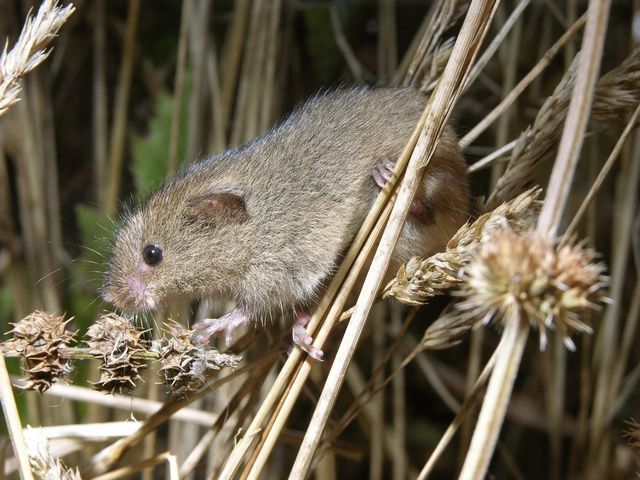| Citation |
|
Description |
Geographic Range [top]
Range Description: The harvest mouse has a large range in the Palaearctic and Indomalayan regions, where it occurs from northern Spain and Great Britain through Europe, eastern Fennoscandia, and Russia to northern Mongolia, China, the Korean peninsula, northeast India, Myanmar and Viet Nam (Corbet 1978, Panteleyev 1998, Spitzenberger 1999); also Japan and Taiwan. It is present on the border between southern Sweden and south-east Norway, where it is regarded as possibly introduced (van der Kooij et al. 2001, Wilson and Reeder 2005, van der Kooij et al. in litt. 2006).
In Europe, it is largely absent from Iberia, southern part of Italy, the Alps, and it occurs only sporadically in the Balkans. It is typically a lowland species, although it occurs at altitudes of up to 1,700 m asl in Europe (Spitzenberger 1999).
It is restricted to the northern parts of Mongolia, including Mongol Altai, Hövsgöl, Hentii and Ikh Hyangan mountain ranges, Mongol Daguur Steppe and Eastern Mongolia.
In Japan, the species is found on Honshu (Miyagi and Niigata Prefectures southwards), Shikoku, Kyushu, as well as the Oki Islands (Dogo, Nishinoshima, and Nakanoshima), Awaji, Teshima, Innoshima, Osaki-kamishima, Tsushima, Shimoshima (Amakusa Islands), Fukue (Goto Islands), and Kuchinoerabu (Osumi Islands) (Abe, et al., 2005). The species is likely found more widely on small islands in the vicinity of the known distribution in Japan (Abe, et al., 2005). The species is found from sea level up to 1,200 m asl in Japan.
Countries occurrence:
Native:
Armenia (Armenia); Austria; Azerbaijan; Belarus; Belgium; Bosnia and Herzegovina; Bulgaria; China; Croatia; Czech Republic; Denmark; Estonia; Finland; France; Georgia; Germany; Greece; Hungary; India; Italy; Korea, Democratic Peoples Republic of; Korea, Republic of; Latvia; Lithuania; Luxembourg; Macedonia, the former Yugoslav Republic of; Moldova; Mongolia; Montenegro; Myanmar; Netherlands; Poland; Romania; Russian Federation; Serbia (Serbia); Slovakia; Slovenia; Spain; Switzerland; Taiwan, Province of China; Turkey; Ukraine; United Kingdom; Viet Nam
Present - origin uncertain:
Japan; Norway; Sweden
Additional data:
? Upper elevation limit (metres): 1700
Range Map: Click here to open the map viewer and explore range.
Population [top]
Population: Population declines have been noted in many parts of Europe. However, populations of this species fluctuate drastically, and some reported declines may in fact have been part of a natural fluctuation (Trout 1978, Haberl and Kryštufek 2003). The species is hard to trap and is often not recorded even when it is present (Haberl and Kryštufek 2003). However, nests may be found quite easily by experienced observers (R. Juškaitis pers. comm. 2006).
It is considered to be common in South Asia.
Current Population Trend: Stable
Additional data:
? Population severely fragmented: No
Habitat and Ecology [top]
Habitat and Ecology: Present in a wide variety of habitats, including alpine grasslands, tall grass fields, bamboo stands, wetlands, reedbeds, and clearings and edges of humid forest. It has also adapted to a variety of anthropogenic habitats, including gardens and arable land (in the wetter north-western parts of its range), drainage ditches, and grain or rice paddies (Spitzenberger 1999). It has a high tolerance of disturbed habitats (Haberl and Kryštufek 2003). Their diet includes seeds, green vegetation, insects, and birds eggs.
Systems: Terrestrial
Threats [top]
Major Threat(s): There are no major threats throughout its range. In Europe the species is common in wetlands (e.g. rice fields) and other habitats (e.g. abandoned agricultural land). There are no serious threats to the survival of the species, although local population declines have occurred in some areas as a result of loss and degradation of wetland habitats (Spitzenberger 1999).
Conservation Actions [top]
Conservation Actions: It is present in several protected areas across its range. In Japan, the species is listed as threatened in a number of prefectures.
Citation: Aplin, K., Lunde, D., Batsaikhan, N., Kryštufek, B., Meinig, H. & Henttonen, H. 2008. Micromys minutus. The IUCN Red List of Threatened Species 2008: e.T13373A3875408. http://dx.doi.org/10.2305/IUCN.UK.2008.RLTS.T13373A3875408.en. Downloaded on 19 August 2016.
Disclaimer: To make use of this information, please check the .
Feedback: If you see any errors or have any questions or suggestions on what is shown on this page, please provide us with feedback so that we can correct or extend the information provided
|


